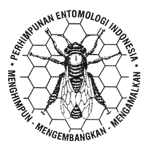Pengendalian Aphis craccivora Koch. dengan kitosan dan pengaruhnya terhadap penularan Bean common mosaic virus strain Black eye cowpea (BCMV-BlC) pada kacang panjang
DOI:
https://doi.org/10.5994/jei.11.2.72Keywords:
feeding preferences, population growth, viral suppression, pest plantAbstract
Aphis craccivora is one of the important pests on yard long bean. It causes direct damage and also has an indirect effect as insect vector of the Bean common mosaic virus (BCMV). The research was done to test the effectiveness of chitosan in suppressing aphid population growth, feeding preference and its ability in transmiting BCMV. Chitosan with concentration ranging of 0.1–1.0% were applied on leaves using spraying method at 1 day before BCMV transmission. BCMV was transmitted by using 3 individuals of viruliferous aphids on each plant. Results show that chitosan treatments on leaves or plants significantly suppressed the population and feeding preferences of A. craccivora. Further, treated plants showed lower disease incidence, severity and BCMV titre significantly compared with untreated control plants. The positive effects of chitosan in suppressing population growth as feeding preferences and BCMV transmission might be due to the anti-feedant effect of chitosan on A. craccivora. Based on the result, chitosan at concentration 0.9% is the most effective concentration in suppressing BCMV and its vector A. craccivora.Downloads
Download data is not yet available.
Downloads
Published
2015-09-17
How to Cite
Megasari, D., Damayanti, T. A., & Santoso, S. (2015). Pengendalian Aphis craccivora Koch. dengan kitosan dan pengaruhnya terhadap penularan Bean common mosaic virus strain Black eye cowpea (BCMV-BlC) pada kacang panjang. Jurnal Entomologi Indonesia, 11(2), 72. https://doi.org/10.5994/jei.11.2.72
Issue
Section
Articles
License
Copyright (c) 2015 Jurnal Entomologi Indonesia

This work is licensed under a Creative Commons Attribution 4.0 International License.
Authors who publish with this journal agree to the following terms:
- Authors retain copyright and grant the journal right of first publication with the work simultaneously licensed under a Creative Commons Attribution 4.0 International License that allows others to share the work with an acknowledgement of the work's authorship and initial publication in this journal.
- Authors are able to enter into separate, additional contractual arrangements for the non-exclusive distribution of the journal's published version of the work (e.g., post it to an institutional repository or publish it in a book), with an acknowledgement of its initial publication in this journal.
- Authors are permitted and encouraged to post their work online (e.g., in institutional repositories or on their website) prior to and during the submission process, as it can lead to productive exchanges, as well as earlier and greater citation of published work (See The Effect of Open Access).








